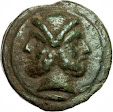My
interest in ancient anchors is related to my cast bronze collection. I
purchased an uncia from Hatria with an anchor on one side and HAT on the other.
Aes Grave Uncia, Hatria, 280 BC (275 – 225 BC)
Obv – Anchor, some coins have an H to the right of the anchor
Rev – HAT surrounding a mark of value, one dot. Some coins have TAH on
reverse.
I found 17 examples on line. See statistics below.
Wt = 31 grams; avg wt = 31 g; Min wt = 20.4; Max wt = 50.4; StDev = 6.8
Diameter = 31.5 max and 30.2 min & 7.3 mm thick; avg = 31 mm; Min =
29; Max = 34; StDev = 1.8
Die axis = 12; of the 13 coins I found on line 13 had a die axis of 12
and one had an axis of 6. This is consistent with other aes grave coins I have.
TV – 186
V – 242
HNI – 16
Syd AG – 191
Haberline plate 16, # 13 - 16
I
normally do a bit of research before buying a coin and a bit more after the fact.
Die rotation is one of the attributes I track. Most cast bronze from Italy have
a die rotation of 0o (or 12 o’clock), the second most common
rotation is 180 o (or 6 o’clock), and all other positions are less common.
I could not tell die rotation for this coin without knowing how the anchor
(anker in German) should be viewed.
It looks to me that the direction an anchor points on an ancient coin changes.
It looks to me that the direction an anchor points on an ancient coin changes.
I
am not an expert on ancient anchors, but have handled many Widow’s Mites.
Most
of these coins are shown with an “inverted” anchor, or the coin is minted with
the point to the top of the coin.
A
recent Agora auction showed an anchor counter mark in the same position: “C/M
Seleukid anchor in oval, flukes upward.”
A
similar coin from LAC: Seleukis Uncertain date. Athena/Nike, c/m: anchor.
Some other Seleukid anchor coins
I have
a couple of Orodes bronze coins with anchors similar to this one above sold by CNG and the ones below sold by LAC.
A
few other examples of points up –
A Brutium coin with an anchor, LAC
Drachms from Thrace have a point up anchor also:
Per CNG the coin above is from Pontika in Northern Greece and was minted in mid-late 4th century BC. The obverse has a facing Gorgoneion and the reverse has an upright anchor.
A similar coin from Artemide Asta
a Corinthian coin from AA has an anchor on the reverse
The
Romans put anchors of both Republican and Imperial coins. Several Aes Grave
coins have anchors. A Vecchi 160/166, minted in Tuder in 260 – 270 BC has a
Frog & Anchor on the obv & rev. The anchor has circles on both ends. The coin was sold by AA.
By
210 BC, bronze coins were struck. The following As has an anchor on the
reverse.
Roman
Republic, AE, struck As, anonymous, 209 – 208 BC
Obv
– head of Janus, above mark of value – I
Rev
– Prow R, above mark of value – I, before anchor, in ex – ROMA with archaic A
(v pointing down)
Cr
50/3
Syd
– 145
34.99
g
About
the same time, the Romans put an anchor on the reverse of the denarius. In this
case the anchor is sideways, but has a connecting circle at both ends.
Roman Republican Denarius
circa 209-208 BC, Rome
Obv - Helmeted head
of Roma r.; behind, X.
Rev - The Dioscuri
galloping r.; below, anchor. In exergue, ROMA in partial tablet.
3.72 grams
Crawford 50/2.
Sydenham 144.
Russo RBW 186.
Rare. Toned. Very
Fine.
Note
that the later anchor denarius has a circle connection only on the end opposite
the V (coin by AA).
I have seen two of the following coins with an anchor. Both are point up. Mine has no eyelets for an attachment rope.
Roman Republican Denarius, L. Calpurnius Piso Frugi, 90 BC, Rome
Obv
– head of Apollo R, before letter, behind anchor
Rev
– galloping horseman R, holding palm branch, above V, below L.PISO.FRVGI
Cr
340/1
A
second coin of the same type has connecting circles at both ends.



























No comments:
Post a Comment